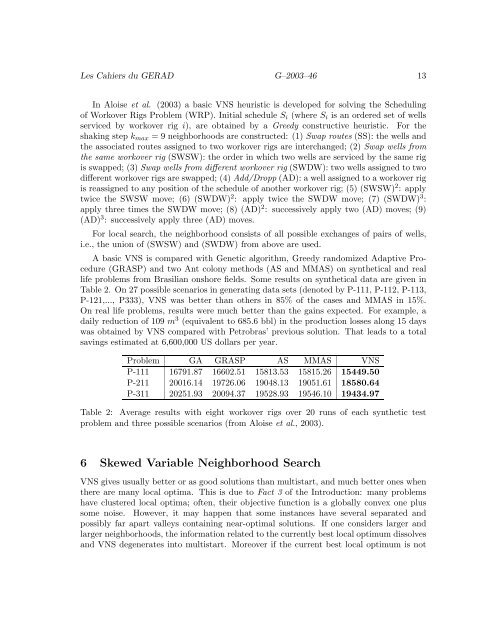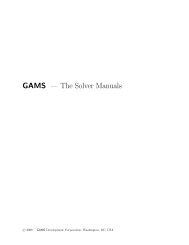A Tutorial on Variable Neighborhood Search
A Tutorial on Variable Neighborhood Search
A Tutorial on Variable Neighborhood Search
You also want an ePaper? Increase the reach of your titles
YUMPU automatically turns print PDFs into web optimized ePapers that Google loves.
Les Cahiers du GERAD G–2003–46 13<br />
In Aloise et al. (2003) a basic VNS heuristic is developed for solving the Scheduling<br />
of Workover Rigs Problem (WRP). Initial schedule S i (where S i is an ordered set of wells<br />
serviced by workover rig i), are obtained by a Greedy c<strong>on</strong>structive heuristic. For the<br />
shaking step k max = 9 neighborhoods are c<strong>on</strong>structed: (1) Swap routes (SS): the wells and<br />
the associated routes assigned to two workover rigs are interchanged; (2) Swap wells from<br />
the same workover rig (SWSW): the order in which two wells are serviced by the same rig<br />
is swapped; (3) Swap wells from different workover rig (SWDW): two wells assigned to two<br />
different workover rigs are swapped; (4) Add/Dropp (AD): a well assigned to a workover rig<br />
is reassigned to any positi<strong>on</strong> of the schedule of another workover rig; (5) (SWSW) 2 : apply<br />
twice the SWSW move; (6) (SWDW) 2 : apply twice the SWDW move; (7) (SWDW) 3 :<br />
apply three times the SWDW move; (8) (AD) 2 : successively apply two (AD) moves; (9)<br />
(AD) 3 : successively apply three (AD) moves.<br />
For local search, the neighborhood c<strong>on</strong>sists of all possible exchanges of pairs of wells,<br />
i.e., the uni<strong>on</strong> of (SWSW) and (SWDW) from above are used.<br />
A basic VNS is compared with Genetic algorithm, Greedy randomized Adaptive Procedure<br />
(GRASP) and two Ant col<strong>on</strong>y methods (AS and MMAS) <strong>on</strong> synthetical and real<br />
life problems from Brasilian <strong>on</strong>shore fields. Some results <strong>on</strong> synthetical data are given in<br />
Table 2. On 27 possible scenarios in generating data sets (denoted by P-111, P-112, P-113,<br />
P-121,..., P333), VNS was better than others in 85% of the cases and MMAS in 15%.<br />
On real life problems, results were much better than the gains expected. For example, a<br />
daily reducti<strong>on</strong> of 109 m 3 (equivalent to 685.6 bbl) in the producti<strong>on</strong> losses al<strong>on</strong>g 15 days<br />
was obtained by VNS compared with Petrobras’ previous soluti<strong>on</strong>. That leads to a total<br />
savings estimated at 6,600,000 US dollars per year.<br />
Problem GA GRASP AS MMAS VNS<br />
P-111 16791.87 16602.51 15813.53 15815.26 15449.50<br />
P-211 20016.14 19726.06 19048.13 19051.61 18580.64<br />
P-311 20251.93 20094.37 19528.93 19546.10 19434.97<br />
Table 2: Average results with eight workover rigs over 20 runs of each synthetic test<br />
problem and three possible scenarios (from Aloise et al., 2003).<br />
6 Skewed <strong>Variable</strong> <strong>Neighborhood</strong> <strong>Search</strong><br />
VNS gives usually better or as good soluti<strong>on</strong>s than multistart, and much better <strong>on</strong>es when<br />
there are many local optima. This is due to Fact 3 of the Introducti<strong>on</strong>: many problems<br />
have clustered local optima; often, their objective functi<strong>on</strong> is a globally c<strong>on</strong>vex <strong>on</strong>e plus<br />
some noise. However, it may happen that some instances have several separated and<br />
possibly far apart valleys c<strong>on</strong>taining near-optimal soluti<strong>on</strong>s. If <strong>on</strong>e c<strong>on</strong>siders larger and<br />
larger neighborhoods, the informati<strong>on</strong> related to the currently best local optimum dissolves<br />
and VNS degenerates into multistart. Moreover if the current best local optimum is not
















